|
The Quest for Life
As far as we know at the present, Earth is the only place in the Universe that hosts life. However, wherever we look on Earth we find living things - on the surface, in the oceans, in the air. We even find life in what we think of as extreme environments - in the ice of the polar regions. Which is where this creature lives.
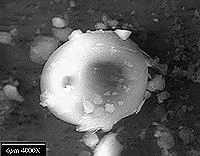 ...Or in minute fissures deep down in the baking, crushing crust of the Earth and on the ocean floor near volcanic vents, where the pressures are enormous and the temperatures are above boiling point. Areas of the mid-Atlantic ridge, so deep in the ocean that no solar radiation reaches them, are such habitats. Here geo-thermal vents, popularly known as black smokers, behave like miniature under-sea volcanoes and belch hot, dark fluid rich in sulphur. Yet life flourishes here, and flourishes well. Not only are bacteria found around these vents, but higher forms of life such as shrimps and crabs and even fish thrive. None of these creatures depends upon solar radiation directly, their lives are sustained by the geo-thermal power of the planet. This tells us that life does not necessarily require the close proximity of a star to sustain it. Provided local energy can be obtained from somewhere, life will exploit it! ...Or in minute fissures deep down in the baking, crushing crust of the Earth and on the ocean floor near volcanic vents, where the pressures are enormous and the temperatures are above boiling point. Areas of the mid-Atlantic ridge, so deep in the ocean that no solar radiation reaches them, are such habitats. Here geo-thermal vents, popularly known as black smokers, behave like miniature under-sea volcanoes and belch hot, dark fluid rich in sulphur. Yet life flourishes here, and flourishes well. Not only are bacteria found around these vents, but higher forms of life such as shrimps and crabs and even fish thrive. None of these creatures depends upon solar radiation directly, their lives are sustained by the geo-thermal power of the planet. This tells us that life does not necessarily require the close proximity of a star to sustain it. Provided local energy can be obtained from somewhere, life will exploit it!
But what about the possibility of life off Planet Earth?
As far back as the seventeenth century, writers like Cerano de Bergerac were musing on the possibility of a race of people living on the Moon. Since then sci-fi writers have been moulding our belief in aliens and colouring our attitudes. However we look at it, there is always some sort of spin, some sort of wish-fulfilment involved, to say nothing of our baser fears. Very few people including scientists, can stand back and look at the evidence dispassionately. The fact is, most people want there to be aliens: they want to believe, as the X-Files would have it. Perhaps the fear of being destroyed or subsumed by aggressive aliens is not as great as the fear of being completely alone in such a vast Universe.
Back in the nineteen-fifties, when the prospect of space travel seemed increasingly plausible, space specialists began to think about how they would recognise life if it were ever found off Earth. Really they were asking "What defines life?" The question is not easy to answer, but seven criteria seemed to apply.
The Seven Criteria for Life
Life must be or have -
1 ...an organised pattern
2 ...self-replication - the ability to store and pass on instructions for same
3 ...able to convert energy
4 ...the ability to change structure
5 ...the ability to evolve
6 ...able to interact with surroundings
7 ...a certain robustness to changes in the environment
Crystals exhibit some of these abilities and fire, others, but neither could be considered as living. Computer viruses on the other hand are thought of as living entities by some people. Other exotic life forms have been postulated, particularly by science fiction writers - gas clouds, plasma beings and living electro-magnetic energy fields but these are all well into realms of speculation.
We are curious about the possibility of life on Mars, so let's look at a place we know harbours life and see how Mars compares. So let's look at the Earth.
Why is our planet so friendly towards life? There are five basic factors that contribute towards Earth being a nice place to live.
Factors for Sustaining Life
Temperature
Gravity
Radiation Control
Tidal Interactions
Materials Re-cycling

Temperature
Firstly, as we have seen, the temperature is a factor. On Earth the temperatures and pressures are such that water can exist in all three phases (gas/vapour, liquid and solid) and this makes the transportation of water easy.
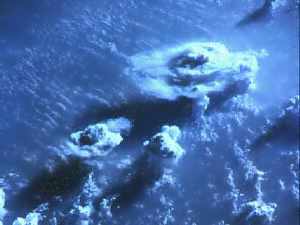 Gravity Gravity
Secondly, the gravitational forces on Earth are strong enough to prevent the atmosphere escaping into space, yet they are weak enough that liquid water suspensions don't settle out very readily. Also, the gravitational forces are low enough that living structures can be built. If gravity were two or three times as strong, then the limitation on living forms would be severe. Living things would probably be no more than thin flat sheets of goo. Indeed this was the case on the early Earth. It took a billion or so years for life to work out how to construct three-dimensional structures more than a single cell thick!
If you don't believe me, think about insects. Why don't we have dragonflies with two metre wingspans? Why no metre long ants? Fortunately their exoskeletal structure, if factored up, would be so heavy that they would be incapable of movement. Gravity limits the options. There is another question here, too. One we don't know the answer to. Can complex life forms evolve in the absence of gravity? Gravity, after all, plays a key role in the mixing and transport processes that life (particularly complex life) relies upon. As we will find out later, it may be possible for life to get started in interstellar, low-gravity space, but could it evolve into more complex entities without the stirring around that only gravity can provide?
Radiation Control
Thirdly, the Earth is bathed in radiation from the Sun and the cosmos that is so severe that it would severely damage most life-forms, if they ever came into contact with it directly. The Earth possesses several barriers that filter out most of the harmful effects of radiation. Firstly, there are the Van Allen belts, which are generated by the Earth's magnetic field. These divert much of the harmful solar radiation around the Earth, so it never reaches the surface. Then there is the ozone layer, which filters out harmful ultraviolet, and finally the atmosphere itself which absorbs a broad spectrum of incoming radiation to some extent.
 Tidal Interactions Tidal Interactions
Tidal interactions of the Moon have been suggested as a significant factor in evolution. Basically the tides stir up the oceans and bring materials into contact with each other, thus helping chemical processes along. In addition the presence of the Moon has a stabilising factor on the Earth's wobble. The Earth precesses and the angle of tilt changes over time. However, this remains within strict limits. The Earth doesn't topple over, as Venus is thought to have done, or present its poles to the Sun as Uranus does. It stays, spinning within fairly confined limits over long time scales, and the presence of the Moon is the reason. The two bodies act as a self-rectifying system when the Earth's tilt starts to drift in, what we would consider, the wrong direction. Additionally, it has been suggested that the Moon plays some part in the generation and maintenance of the Earth's magnetic field; and as we have seen this is important. Not only that, as we will see when we consider the final factor, the Moon has a significant effect on geological activity on Earth.
 Materials Re-cycling Materials Re-cycling
Finally, there is what can be called materials re-cycling. The geological structure of the Earth is unique as far as we know. It is the only planet that displays active tectonic activity, although Mars now appears to have had such processes happening in the past. But what exactly is it? The Earth's crust is made up of several tectonic plates which float on the mantle, which surrounds the core. The crust and the mantle are both thermally active through radio-active decay of minerals, while residual heat from the Earth's formation is still making its way to the surface. It is assumed that the convection caused by this heating contributes to plate movement. Tidal interaction with the Moon may also be an important factor. In some places, such as the mid ocean ridges, new surfaces are being created and flow out of the Earth's interior creating an ocean floor like a conveyor belt. In other zones, such as the coast of Chile, the opposite is happening. Crust is being subducted, down into the Earth to be recycled into new continental matter, in this case building the Andes. © Image: S A Hodges
So how does this affect life? Well, by controlling the availability of carbon. Carbon dioxide is a major constituent of the atmospheres of Mars and Venus, and at one time the same was true here. On Earth, and probably on Mars, where water was available, the carbon dioxide was taken into solution and deposited as calcium carbonate, what we call oolitic limestone. Later, on Earth, life was able to lock-up more of the carbon - in animals, plants and subsequently rocks, such as fossil limestones, chalk and shales. Thus saving Earth's atmosphere from becoming a carbon-dioxide dominated, run-away greenhouse.
 Mars Mars
So how about life on Mars? Mars always was the most favoured place for alien life. Ever since Percival Lowell claimed that Mars had a vast canal system - sadly the result of optical illusion and an over active imagination - the planet has been thought of as the home of the archetypal alien in the popular imagination. HG Wells perpetuated this myth with "War of the Worlds", and Edgar Rice Burrows reinforced it. By the time the early Mariner spacecraft arrived at Mars in the 1960's, many of the general public were expecting to see a planet teeming with plant and animal, if not intelligent, life. They were sadly disappointed.
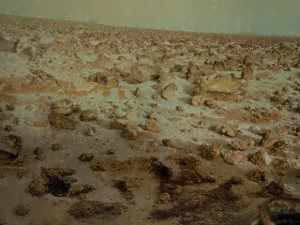 The first successful soft-landings by the Viking spacecraft carried out a series of tests for life, and these have been somewhat controversial ever since. The official view, and the one to which most scientists currently subscribe, is that the tests were negative, or at best inconclusive. The first Viking lander produced positive results and the second produced no results. However it is claimed that inorganic peroxides could also have produced the positive results in the first test. Eventually, the official conclusion was that peroxides were present on the Martian surface. Dr Levin - the NASA scientist who designed the tests - however, still maintains more than twenty years on that the first test, at least, was positive. Had the tests been carried out on Earth and the same results been obtained, then the conclusions would have been: Yes! Life exists here. The first successful soft-landings by the Viking spacecraft carried out a series of tests for life, and these have been somewhat controversial ever since. The official view, and the one to which most scientists currently subscribe, is that the tests were negative, or at best inconclusive. The first Viking lander produced positive results and the second produced no results. However it is claimed that inorganic peroxides could also have produced the positive results in the first test. Eventually, the official conclusion was that peroxides were present on the Martian surface. Dr Levin - the NASA scientist who designed the tests - however, still maintains more than twenty years on that the first test, at least, was positive. Had the tests been carried out on Earth and the same results been obtained, then the conclusions would have been: Yes! Life exists here.
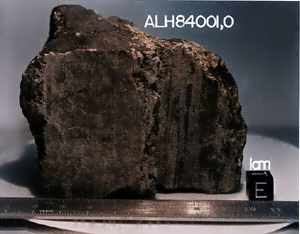 Since then we have had the on-going Martian meteorite saga. Meteorite ALH 84001 was found in the Antarctic a few years ago. The arguments raging on each side are currently fierce, but well made and it remains to be seen which side will prevail. Since then we have had the on-going Martian meteorite saga. Meteorite ALH 84001 was found in the Antarctic a few years ago. The arguments raging on each side are currently fierce, but well made and it remains to be seen which side will prevail.
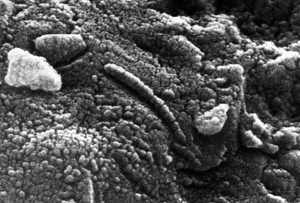 A minute caterpillar-like structure was found deep inside the meteorite. It was claimed this was a fossil bacteria, for it looked similar to some found on Earth. However, it was about one-hundredth the size of an Earth bacteria and other scientists argued that it was simply too small and was just part of the minerals occuring in the rock. That seemed an end to the initial euphoria, but then other teams of biologists came up with an astounding discovery: super-minute bacteria, of the type found in the meteorite, do exist on Earth and are responsible for a wide range of diseases, including such common ailments as kidney stones. So the row swung back to the life protagonists. The antagonists then came back with a highly critical report, on the way the initial tests had been carried out, and allegedly showed that the sample had been contaminated on Earth, probably while it lay in the ice for 20,000 years. Though one has to wonder how the alleged bacteria got so far inside the meteorite and then became fossilised, in such adverse environmental conditions and in such a short time. A minute caterpillar-like structure was found deep inside the meteorite. It was claimed this was a fossil bacteria, for it looked similar to some found on Earth. However, it was about one-hundredth the size of an Earth bacteria and other scientists argued that it was simply too small and was just part of the minerals occuring in the rock. That seemed an end to the initial euphoria, but then other teams of biologists came up with an astounding discovery: super-minute bacteria, of the type found in the meteorite, do exist on Earth and are responsible for a wide range of diseases, including such common ailments as kidney stones. So the row swung back to the life protagonists. The antagonists then came back with a highly critical report, on the way the initial tests had been carried out, and allegedly showed that the sample had been contaminated on Earth, probably while it lay in the ice for 20,000 years. Though one has to wonder how the alleged bacteria got so far inside the meteorite and then became fossilised, in such adverse environmental conditions and in such a short time.
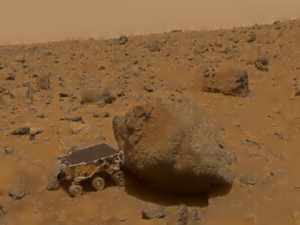
The Pathfinder lander which arrived on Mars in 1997, was not looking for life and has really raised more questions about the life debate, by suggesting from the rock spectral analysis that sedimentary rocks exist on Mars. While this does not demonstrate the existence of life directly, it does imply that liquid water existed for some considerable time on the surface, and this is a pre-requisite for carbon-based life. © Image: NASA/JPL

Other photographic evidence from Viking, and the more recent Global Surveyor, strongly suggest the existence of oceanic shorelines in some parts, notably in the low lying bottom of the Valles Marineris - the great canyon that runs across nearly a quarter of the planet. Again this is circumstantial support for the possibility of life.
The European Space Agency Mars Express/Beagle2 project may land in the valley and one of the many NASA probes will almost certainly go there in the next few years, probably with a robot rover. The results will be interesting to see.
The real case against carbon-based life on Mars currently being active, or active in the past for any length of time, comes from the fact that the atmosphere is largely carbon dioxide. Almost the first thing that developing living organisms do in the presence of CO2 is use it! Had life existed in any abundance, then the CO2 would have been converted into something else - limestone perhaps. It is true that limestone has been detected on Mars, but this is thought to be oolitic - precipitated from water and not from living matter.
So was the atmosphere giving us the clue all along: are we wasting our time searching for life on Mars? 
Return to Rover
|













